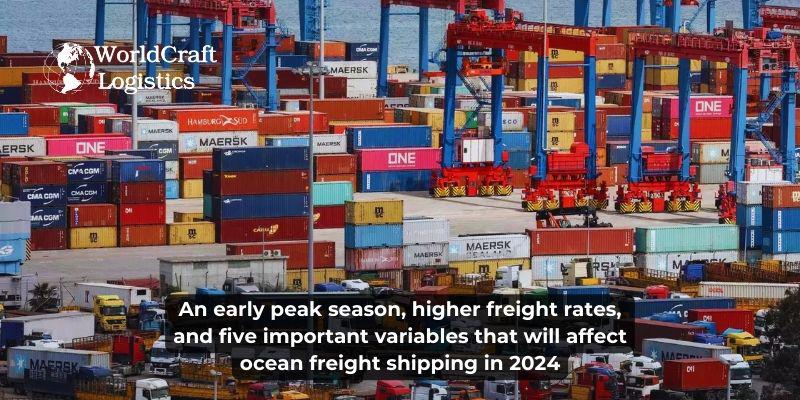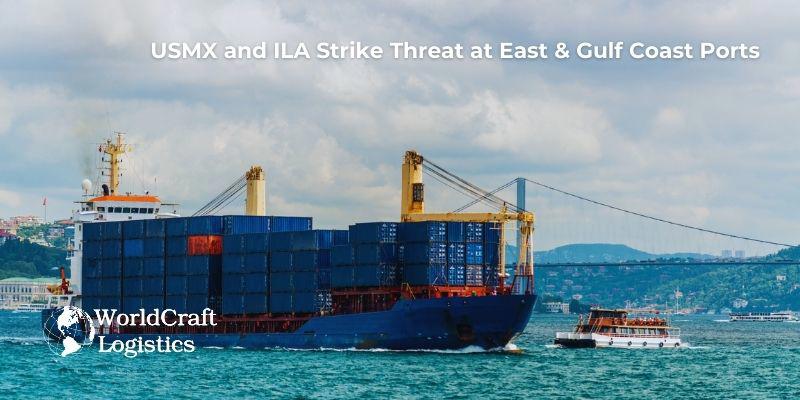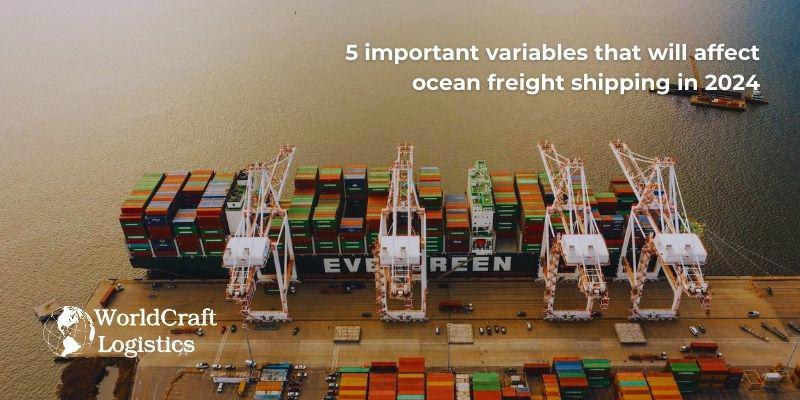
Starting June 1st, 2023 Our warehouse fee will be $0.65/cubic foot per month
In effort to lower the warehouse storage fee during inflation, we have went narrow aisle racking.This construction took us four months but the project is finally completed. With narrow aisle racking, we are able to drop storage by 24%.We as partners will go through this inflation together.
06/24/2024

An early peak season for international shipping is unfolding this year, a shift that’s not entirely unprecedented. Industry reports show that demand for ocean freight surged in April and May, mirroring typical increases seen from June through September. WorldCraft Logistics corroborates this trend, with internal data revealing a 30% rise in shipments in April and an additional 8% in May.

This spike in demand, coupled with current cargo constraints, has led to a significant increase in ocean freight spot rates, with some reports describing these rates as skyrocketing. The situation resembles the freight rate surge during the pandemic and the initial Houthi attacks in the Red Sea. The critical question remains: Are we witnessing a temporary spike in freight rates, or will these high rates persist over the long term?
Let’s examine five factors currently influencing international shipping to see if projections can be made.
Iran-backed Houthi attacks in the Red Sea and Gulf of Aden persist, with reports indicating an expansion in the rebels' attack range. This escalation necessitates the continuation of round-Africa services, straining vessel capacity and contributing to shortages. Unfortunately, there is no end in sight for the Houthi attacks and resulting vessel diversions.
Simultaneously, port congestion is affecting Asian and Western Mediterranean shipping hubs. A surge in demand is worsening the situation, causing longer waiting times for vessels. This further constraints global ocean freight capacity, impacting supply chains worldwide.

Perhaps ocean freight carriers have more foresight than they're credited for. Recently, the industry saw an influx of ships and capacity. Initially, this surge was expected to create overcapacity and force carriers into an unfavorable position with low freight rates and high losses.
Instead, this capacity became crucial when drought restricted ships crossing the Panama Canal and Houthi attacks forced carriers to divert around Africa instead of using the Suez Canal.
There might have been some luck with the arrival of this capacity, but carriers are also implementing other strategies to manage capacity more effectively.
Ocean freight carriers are aiming to boost their profits by driving up and maintaining higher freight rates for a healthier bottom line. Currently, freight rates are exceptionally high.
In April and May, freight rates surged unexpectedly, taking many shippers by surprise, and further increases seem imminent. Shippers should prepare for an average general rate increase (GRI) of $1,000 across all carriers in the first week of June.
Shippers should also be wary of additional “space protection” fees. With capacity constraints and rising rates, booking options may become limited. This is a situation some carriers seem poised to exploit.
I opened this post on the topic of the peak season starting a bit early this year. Here is a little more data to the point.
The National Retail Federation (NRF) projects that U.S. monthly ocean imports will surpass two million TEUs in May, peaking at 2.1 million in August. Often, the peak season peaks in September or October.
Several factors explain why shippers are importing earlier this year. Among them are delays due to the Suez Canal/Red Sea diversions we've previously discussed, but there are other reasons as well…

In our recent strategy, which we've suggested before, we included the tactic of shipping early to avoid potential port disruption when the ILA’s contract expires on September 30th.
Both the United States Maritime Alliance (USMX) and the International Longshoremen’s Association (ILA) are committed to avoiding port disruption during contract negotiations, recalling the significant disruption during the 2014-15 ILWU contract negotiations on the West Coast. However, the ILA’s threat of a strike during the upcoming negotiations makes shippers understandably anxious.
Failed or stalled negotiations could impede East and Gulf Coast ports' ability to handle cargo during the typically strong peak season. An early start to the peak season may result in an earlier slowdown, potentially making October slower than usual when the current ILA contract expires. This slowdown could happen even earlier, as the NRF projects imports to peak in August. Nevertheless, a peak in August could still mean strong numbers for September.
Read more:
👉 The impact of new maritime regulations on importers & exporters
👉 The Gulf Coast ports recorded a variety of shipments in April
👉 A sudden container bottleneck raises maritime freight rates, triggering global trade worries
In summary, international shipping, particularly for U.S. shippers, faces several challenges. Significant increases in demand and freight rates early in the peak season could result in a weaker-than-usual end to the peak season. Shippers should expect freight rates to remain high in June, and if NRF’s projections hold, in July and August as well. Even without NRF’s August peak projection, it would be surprising if July and August did not maintain the current peak season demand.
September, however, will be interesting to watch. Many shippers may aim to complete their shipments before September due to potential disruptions from the ILA negotiations. A last-minute surge might occur just before the master contract for East and Gulf Coast dockworkers expires. There’s a chance of a downturn in September, but if the peak season ends early, October could see lower-than-normal importing activity.

Despite considerable economic uncertainty, retailers still anticipate high consumer spending, which may sustain demand beyond August and throughout the peak season months. However, a market share surge in imports, and likely exports too, is expected for West Coast ports, reducing East and Gulf Coasts’ share in October and November. September could also experience this market share adjustment.
My best estimate for freight rates is that they will remain high for the next couple of months, at least, but might start declining by October. Significant drops are more likely towards the end of the year. However, if the ILA strikes, another surge in freight rates could occur starting in October and extending into the year's final months.
SEO
Digital Marketing/SEO Specialist
Simon Mang is an SEO and Digital Marketing expert at Wordcraft Logistics. With many years of experience in the field of digital marketing, he has shaped and built strategies to effectively promote Wordcraft Logistics' online presence. With a deep understanding of the logistics industry, I have shared more than 500 specialized articles on many different topics.

Hot News
08/05/2024

Hot News
02/23/2023

Hot News
02/23/2023

Hot News
02/06/2023
Hot News
02/07/2023